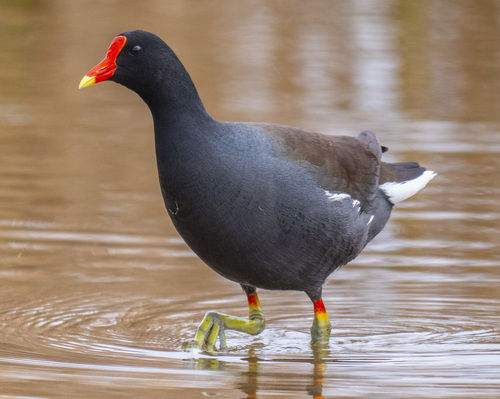
Common Gallinule
The Common Gallinule (Gallinula galeata) is a medium-sized marsh bird found across a wide range of wetland habitats in the Americas. It is easily recognized by its dark plumage, distinctive red frontal shield, and white undertail coverts. This adaptable species plays an important role in wetland ecosystems, primarily as a consumer of aquatic vegetation and invertebrates, and serves as prey for larger predators. It holds little significant cultural importance, but is a familiar sight in many wetland parks and reserves.
32-38 cm
Length
50-55 cm
Wingspan
Least Concern
Conservation Status
Distribution
The Common Gallinule is found throughout North, Central, and South America, as well as the Caribbean. Its range extends from southern Canada, through the United States and Mexico, and south to Argentina and Chile. Some populations are migratory, moving to warmer areas during winter, while others are resident year-round. It is found in a variety of altitudes, from sea level to approximately 3000m.
Lifespan
Up to 9 years has been recorded, but average lifespan is likely shorter.
Common Gallinule's Habitat
Habitat Types
Freshwater marshes, Swamps, Lakes, Ponds, Slow-moving rivers, Canals, Rice paddies
Climate Zones
Tropical, Subtropical, Temperate
Adaptations
Common Gallinules have long toes that help them walk on floating vegetation and soft mud. They are also capable swimmers and divers, although they are not as aquatic as some other members of the Rallidae family.
Variations
Several subspecies of the Common Gallinule have been described, based on slight variations in plumage and size. These variations are often subtle and require expert examination to distinguish.
Appearance
Breeding Plumage
Plumage is generally similar year-round, although the colors may be slightly brighter during the breeding season.
Seasonal Feather Changes
Limited seasonal variation. Some individuals may show slightly brighter red on the frontal shield during breeding.
Sex Based Plumage Differences
Males and females have similar plumage.
Notable Features
Bright red frontal shield, Yellow-tipped red bill, Dark, slate-gray plumage, White undertail coverts, Long, greenish-yellow legs and toes
Diet and Feeding
Primary Foods
Aquatic plants, Seeds, Insects, Snails, Small crustaceans, Occasionally small fish and amphibians
Foraging Behavior
Common Gallinules forage by walking along the edges of water bodies, probing in mud, and picking food from the surface of the water or vegetation. They also swim and dive to obtain food.
Specializations
Their long toes provide stability on soft substrates and allow them to walk on floating vegetation while foraging.
Seasonal Diet Variations
Diet may shift slightly depending on the availability of food resources. During the breeding season, they may consume more insects and invertebrates to meet the increased protein demands of raising young.
Behavior
Social Structure
Common Gallinules are generally found in pairs or small family groups. During the non-breeding season, they may form larger flocks.
Communication
Loud, cackling calls, Clucking sounds, Visual displays, such as flicking their tails to expose the white undertail coverts
Migration
Some populations are migratory, while others are resident. Migratory populations typically move to warmer areas with open water during the winter.
Territorial or Group Behaviors
During the breeding season, Common Gallinules are territorial and will defend their nesting areas from intruders. Outside of the breeding season, they are more gregarious.
Conservation
Threats
Habitat loss and degradation due to wetland drainage and development, Pollution of wetlands, Hunting in some areas, Predation by introduced species
Protection Programs
Wetland conservation and restoration efforts, Legal protection in some countries
Local National Laws
Protected under the Migratory Bird Treaty Act in the United States and Canada.
Population Trend
Stable
Population Estimates
The global population is estimated to be in the millions, but precise numbers are difficult to obtain.
Interesting Facts
Common Gallinules are known for their 'chicken-like' appearance and behavior.
They often walk with a jerky, head-bobbing motion, similar to that of a chicken.
They can be surprisingly aggressive.
During the breeding season, they will fiercely defend their territories against other gallinules and even larger birds.
The chicks have sharp claws on their wings.
These claws help them climb through vegetation and cling to the nest.
They were previously considered the same species as the Common Moorhen.
The Common Gallinule was formerly classified as *Gallinula chloropus*, but was later split based on molecular and morphological data.
Faqs about Common Gallinule
What is the difference between a Common Gallinule and a Common Moorhen?
The Common Gallinule (*Gallinula galeata*) is found in the Americas, while the Common Moorhen (*Gallinula chloropus*) is found in Eurasia, Africa, and parts of Oceania. The Common Gallinule was previously considered a subspecies of the Common Moorhen.
Are Common Gallinules good swimmers?
Yes, they are capable swimmers and divers, although they spend more time walking on vegetation than swimming.
Do Common Gallinules migrate?
Some populations are migratory, moving to warmer areas with open water during the winter, while other populations are resident year-round.
Copyright @ Nature Style Limited. All Rights Reserved.
 English
English